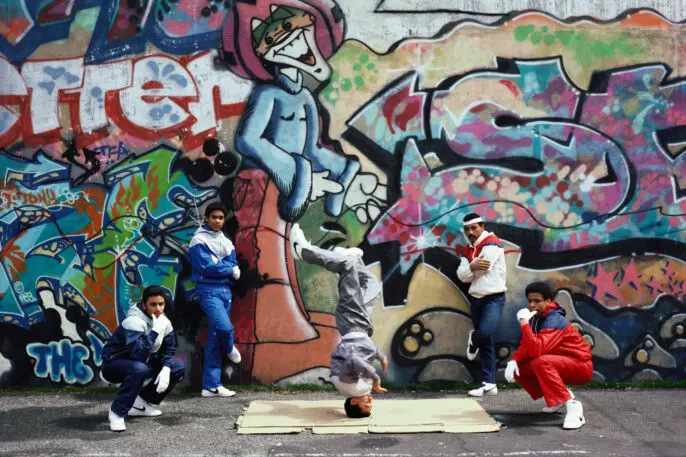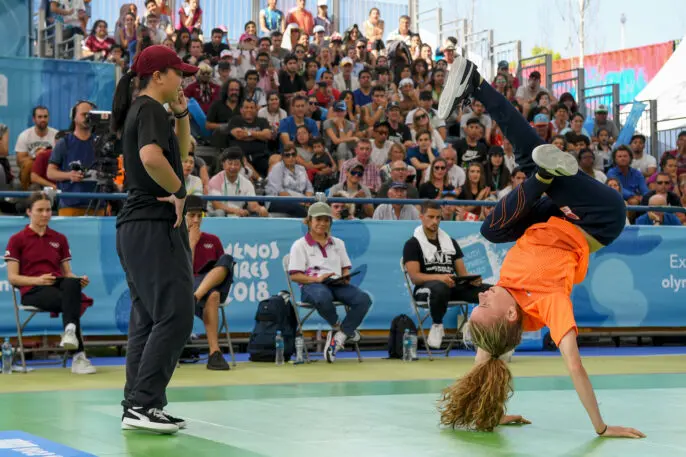If you haven’t thought much about breakdancing since Breakin’ 2: Electric Boogaloo hit multiplexes in 1984 —or are too young to know what that even is—it may come as a surprise to learn that a competitive headspin-to-headspin “dancesport” version of the form has been steadily growing in global popularity over the last few decades and is now set to become the newest Olympic event.
The sport, which will officially go by the name “breaking” when it makes its debut at the 2024 Summer Games in Paris, is part of the International Olympic Committee’s efforts in recent years to attract younger viewers with globally popular subculture-based events like skateboarding, BMX, and rock climbing (all of which made their first official appearances at the last summer games in Tokyo).
In breaking competitions, pairs of dancers face off in “battles”—adapting their moves in response to music selected, mixed, and scratched by a DJ. “One dancer will have a performance and then the other one will try to outdo them in some way—viewers will see dancers facing off against each other, doing rounds against each other,” says veteran U.K.-based DJ and breakdancing judge Kevin “Renegade” Gopie, who co-created the scoring system, called Trivium, that will be used in the Olympics. “Unlike a lot of other sports where each person does their performance independently and then is scored, our sport is scored comparatively.”
In the Trivium system, officials compare each battle dancer’s moves and style to their opponent’s, with special scrutiny paid to categories called “body” (physical moves), “mind” (creativity in response to the music and the opponent’s moves), and “soul” (interpretive flair and style). Because each battle is judged comparatively, strategic competitors will study their opponents’ strengths and weaknesses in order to capitalize on them on the dance floor. “If I know that your weakness is footwork, for instance, I’d do some footwork because I’d know you wouldn’t be able to respond,” says Niels “Storm” Robitzky, the Berlin, Germany-based dancer and judge who co-created the scoring system.
(For a taste of the modern competitive format, check out the boys’ and girls’ finals from the 2018 Youth Olympic Games in Argentina, which included breakdancing as a way of testing the sport’s viability for the main Olympic games. The experiment was a major success, with The Washington Post reporting that “breaking turned in bigger social media numbers than any other sport in Buenos Aires.”)

But how did breakdancing—which achieved its first wave of mass appeal when it burst out of the outer boroughs of New York alongside other forms of urban B-boy culture like rapping and graffiti—regain such broad international popularity that it is now coming to the Olympics? “After the massive explosion of hip-hop worldwide in ‘82, ’83, the fad was over and the flame was going out by ’86,” says Renegade. “But in Europe and the U.K., we continued to hold competitions, and we began networking with dancers [and a loose federation of other leagues] around the world.”
Diehards in Germany, the U.K., the U.S., Scandinavia, Japan, and beyond nurtured the flame—with events growing in size and stature until the biggest comps began getting sponsored by brands like Red Bull and Monster Energy. Dedicated breaking websites and, later, viral YouTube videos gave the scene a massive boost, with dancers from all corners of the globe inspired to invent new moves and outdo each other. Says Storm: “You’ll have a kid in the middle of nowhere in Russia who has nothing to do all day except dance.”

As attention gathers, the longtime underground culture is changing rapidly. “Practice facilities and gyms are opening up, certain athletes get nutritionists,” says Storm, “something we never had back in the day!” Now, Renegade says, top breakdancing athletes are fielding endorsement requests from Nike, Adidas, and others: “Our scene has very special young dancers—athletes—with something to say, with interesting lifestyles. There’s massive potential for those companies to benefit from what we do.”

Recognize your brand’s excellence by applying to this year’s Brands That Matter Awards before the early-rate deadline, May 3.
